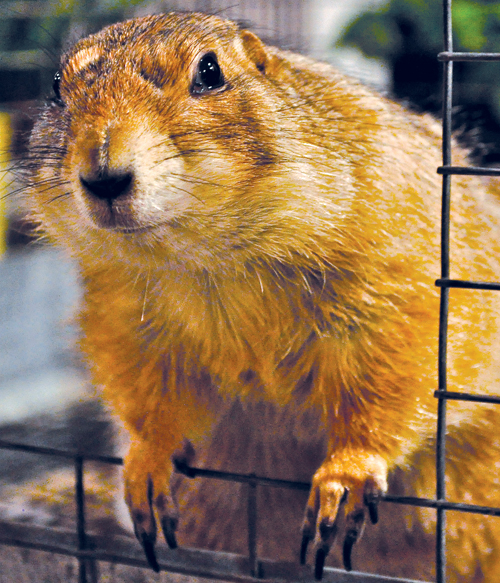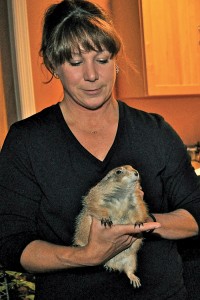A prairie dog companion; two of ’em call Southold home

Their names are Nitro and Methane, but they aren’t drag racers.
They’re a pair of unique pets: two black-tailed prairie dogs that have called Donna and Rob Jester’s Southold home their own for 2 1/2 years now.
And the Jesters say they couldn’t be happier to have the two female prairie dogs in their lives.

“When we come home, they bark to greet us,” said Ms. Jester, who works at Tyler’s Automotive in Mattituck, describing the homecoming ritual. “They stand up on their hind legs and throw their heads back when they do it.”
Mr. Jester, an airplane engine mechanic by trade, likened the daily exchange of squeaks to a parked car’s alarm setting off another car alarm nearby.
“They set one another off,” he said. “They can go back and forth like that five and six times.”
When the Jesters approach the rodents’ cages to pet them, the prairie dogs bare their teeth, but it’s not a malicious gesture — it’s friendly.
“She opens her mouth like that when I pet her because that’s how they greet each other in the wild,” Ms. Jester explained. “It’s like a kiss.”
She added that because prairie dogs are extremely social, the couple keeps them in cages in the living room where the two will be sure to spend the maximum amount of time with their human caregivers.
“They’re so social that if we had them upstairs in our bedroom, where they could hear us not giving them attention, they could actually get sick and literally die from lack of affection,” she said.
This is also the reason the couple is careful to keep their prairie dogs in pairs.
So far, the Jesters have had three sets.
“Nitro bothers Methane, so this is the first pair we’ve kept in separate cages,” Ms. Jester said. “All the other ones have been in the same cage. They’ve bonded to us more closely as a result, so Methane is my prairie dog and Nitro is Rob’s prairie dog.”
Pet prairie dogs were banned in the United States by the FDA for five years between 2003 and 2008, when Ms. Jester said a spider shipped in from another country bit a prairie dog and infected it with monkey pox. After that prairie dog was shipped to another pet store, it infected others and during that time, the couple said, keeping a prairie dog as a pet was taboo.
The couple said they were lucky enough to have a pair that predated the monkey pox period and thus they quietly sailed through the ordeal without having to forgo a pet.
The Jesters have housed an assortment of other unusual pets over the years such as sugar gliders and chinchillas. They were introduced to the world of the prairie dog more than 15 years ago.
“We were watching Marc Marrone [from the TV show, ‘Animal Island’] and he had two prairie dogs named Bubbles and Squeak on there,” Mr. Jester recalled. “He was just talking about how great, social, well-behaved and clean they were, so we decided to go see them at his pet store, Parrots of the World in Rockville Centre, and then we got two of them one spring.”
Before making the eight-year commitment, which is the average life span for a prairie dog in captivity, the Jesters researched the animals to make sure they were making the right decision.
Ms. Jester explained how research helped them get the acquisition process down to a science.
“All of my prairie dogs have come from Texas and they’re only available in pet stores during April and May after the pups have been born,” she said. “They’re wild, so with padded septic trucks, the pups are vacuumed out of the prairie dog colony in the ground. Any adults that are sucked up along with the pups are just put back into the colony.”
About.com states that humans help to control the prairie dog population in this manner. The population was controlled naturally through predation by the black-footed ferret before humans drove the ferret species to near-extinction.
An important part of the acquisition process, Ms. Jester said, has been setting aside at least three days to handle the new pups enough to tame them.
“We’ve always taken days off work,” she said. “We’d take Friday off, go get them and usually after three days of really, really handling them, you’re done.”
Another important taming tactic is to ensure that the prairie dogs know who’s boss, she said.
“You don’t want to let them leap out of their cages,” she said. “After about a day they’ll want to leap out of the cage to come out, but you don’t want to let them do that because then they’ll think of the house as their territory.”
To ensure that they remain top dogs, as it were, the Jesters have kept a strict pick-up policy with their prairie dogs.
“It’s like, ‘You don’t leap you when you want,’ ” Mr. Jester said of the policy. “ ‘You get picked up when you’re ready to come out.’ ”
The couple also spay their prairie dogs to avoid the nastiness associated with the animals’ rut.
“They’ve all been females because I think males try to be more dominant. I’ve also read that if you don’t spay them, they can get nasty in the wintertime and want to hibernate,” Ms. Jester said. “So we’ve always gotten ours in April or May and spayed them the following fall before their first heat.”
When spayed, the animals aren’t as temperamental and the Jesters said Nitro and Methane are a joy to have around the house. Ms. Jester said she won’t allow the cage-trained prairie dogs to roam free without supervision, but they are often allowed out of their cages for exercise and recreation when someone is watching.
Like hamsters, prairie dogs can also get exercise on a wheel, but Mr. Jester said Nitro is an individual in that regard.
“Nitro won’t run on a wheel,” he said. “She doesn’t like it, never touched it, won’t do it, so we got her a bunch of other toys to occupy her.”
In addition to pellets and seeds, prairie dogs, which weigh between one and three pounds, will eat grass and the Jesters grow their own stock of wheat grass to feed to their pets after their first prairie dog pair met with a tragic end.
“They passed away suddenly,” Ms. Jester said. “The landlords of the apartment we lived in were meticulous so we would cut wild grass instead of theirs. Then one spring, something was on the grass and within 48 hours both of them had passed away.”
She added that because of the species uniqueness, the couple was lucky to find Dr. Robert Pisciotta at North Fork Animal Hospital to be Nitro and Methane’s vet.
“Dr. Pisciotta went to school in Arizona so he’s handled hundreds of these guys,” she said. “He and his entire staff are awesome with them.”








